New developments in semiconductor laser technology are enabling the use of laser projection for entertainment, while high-beam-quality, near-infrared diode laser modules are aiding materials processing applications. Growth is expected in both of these emerging markets in the near future.
DR. JÖRG Neukum, Dilas Diodenlaser GmbH
New applications for diode lasers are opening up in the field of laser projection, as well as in the high-brightness materials processing market. Combining visible high-power diode lasers in the red and blue spectral range with a green laser beam (generated by frequency-doubled, solid-state lasers or green diode lasers), laser projection is used in movie theaters, as well as for simulator projection.
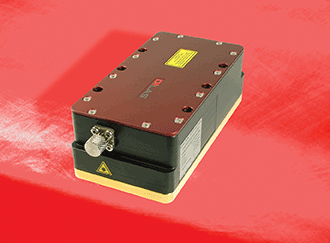
A 638-nm red fiber-coupled laser module.
Another market is emerging in the field of high-brightness materials processing, such as cutting and remote welding. With new developments based on high-brightness diode laser bars, combined with polarization and dense wavelength multiplexing, such technologies have been demonstrated with beam qualities in the range of 10 mm mrad.
Diode laser modules for projection applications
Over the years, multiple approaches have been made to bring laser projection to the market, and commercialization is now finally taking off. Initial installations of laser projection in movie theaters have been completed; the technology’s advantages include:
• Brightness, particularly in the color range and real black impression.
• Lifetime, compared to xenon lamp-based projection.
• No focal plane, making curved screens possible.
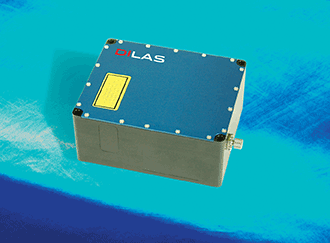
A 450-nm blue fiber-coupled laser module.
The latter is of interest for simulators in automotive and aircraft industries, as well as 3D projection such as IMAX. Yet, the laser projection also offers a step forward in terms of color saturation.
Human eyes’ color receptiveness is based on three different color receptors. With three appropriately chosen red-green-blue wavelengths, a white light impression is generated (Figure 1). Modern laser technology allows the generation of green light (approximately 532 nm) by frequency doubling of high-power, diode-pumped solid-state lasers, but it is much harder to generate the needed red and blue laser beams by harmonic generation. Subsequently, the semiconductor laser technology allows the wavelength to be tailored within certain limits.
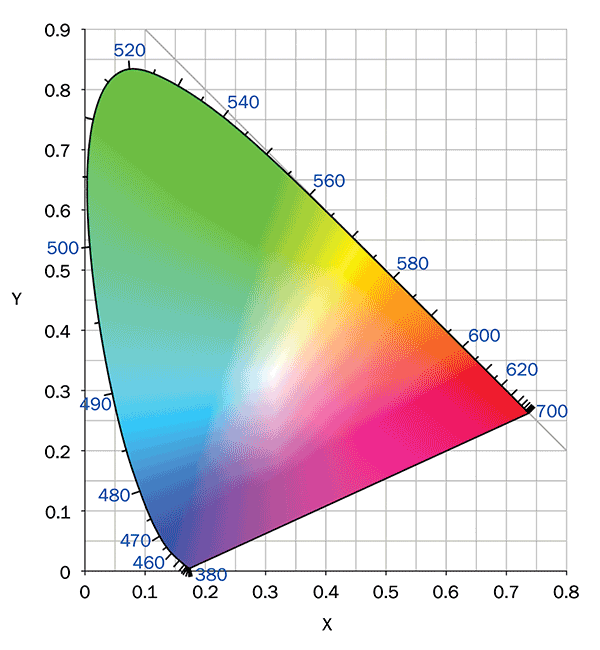
Figure 1. Color chromaticity space.
AlGaInP structures are used to generate 638-nm (DILAS’ red tailored bar module) laser radiation. Power scaling is reached by using laser bars with multiple laser emitters per chip and long resonator
length. Power levels in the range of 8 to 10 W per 5-mm-wide laser bar are available. Higher power levels are achieved by optically stacking the beams of a number of laser bars and subsequent beam shaping. Modules with 40 and 80 W in 400-µm diameter fiber with numerical aperture (NA) of 0.2 are commercially available today, and concepts for further power scaling exist (Figures 2a and 2c).
Additionally, the invention of the GaN diode laser has opened up the blue and UV spectral range for semiconductor lasers. High-efficiency, 450-nm (DILAS’ blue, single emitter module) laser radiation can be generated by single emitter diode lasers. Again, power scaling is achieved by using multiple-single emitters and beam combination. Commercially available power levels up to 25 W in 200-µm diameter fiber, NA of 0.2, with further power scaling are expected (Figures 2b and 2d).
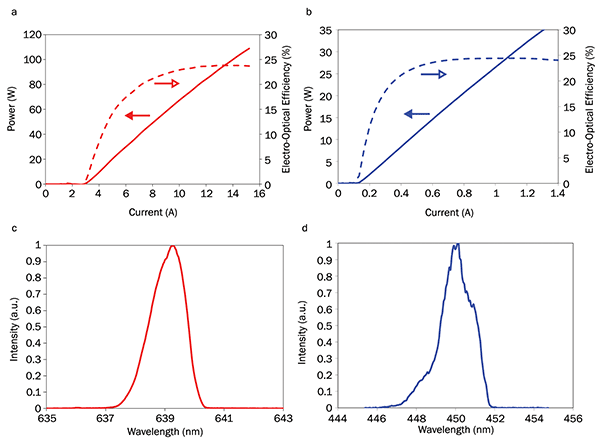
Figure 2. Power and electro-optical efficiency for a 638-nm red fiber-coupled module (400-µm diameter, NA0.2), based on 14 red laser bars (a) and a 450-nm blue fiber-coupled module (200-µm diameter, NA0.2), based on 24 single emitter diode lasers (b); a typical spectrum of a multi-bar-based, red fiber-coupled module. At 80 W and 20 °C the central wavelength is 639 nm, and the 90 percent line width is 1.7 nm (c); a typical spectrum of a multi-single emitter-based, blue fiber-coupled module (d).
The same concept will apply when green semiconductor lasers are available with sufficient power and reliability. Currently available are approximately 520-nm laser diodes with power levels between 100 mW and 1 W.
For movie theater projection, many modules are combined within the laser projectors. Taking into account the sensitivity of the human eye, different power levels for different wavelengths are chosen. Laser projectors are offering a total of up to several tens of thousands of lumens. Movie theaters are now taking advantage of this technology to offer an even more brilliant impression.
Besides curved screens, the laser allows 3D projection to go even further. By introducing two slightly different sets of red, green and blue sources (RGB1 and RBG2), combined with goggles that allow the different color sets to reach the left or the right, the 3D viewing experience will be enhanced.
High-brightness, near-infrared diode laser systems
For a long time, high-brightness applications, such as cutting or remote welding, were not accessible for semiconductor laser-based systems. For these applications, beam parameter products well below20 mm mrad are necessary. In terms of using fibers with NA of 0.2 for delivery and to maintain flexibility, this corresponds to fiber diameters of 100-µm diameter core. With the introduction of tailored bars for fiber-coupled module manufacturing in an automated production line, demonstrated by DILAS, with more than 20,000 modules shipped for fiber laser pumping at 20 mm mrad — the tailored bar concept allows the simplified optical train, highest coupling efficiencies and unparalleled consistency.
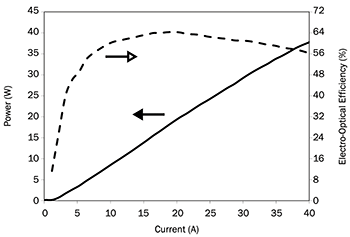
Figure 3. Power and efficiency of a single tailored bar with 50-µm stripe width per emitter. Design goal is 30 W and a beam parameter product of 7.5 mm mrad.

As mentioned previously, all optical components are mounted automatically with active alignment to ensure very high consistency and to minimize pointing errors, which is important for beam quality with regard to fiber coupling or wavelength stabilization. The latter is possible by using a single volume holographic grating (VHG) for the whole set of laser bars.
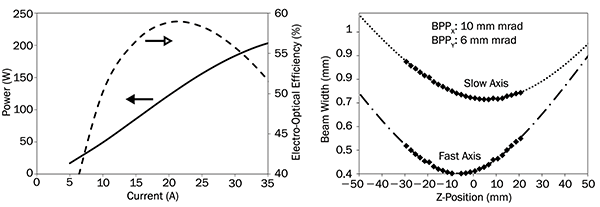
Figure 4. Power and efficiency of a free-beam setup of seven improved tailored bars, as well as a free-beam caustic-scan. With 185 W at 30 A, a power conversion efficiency of 55 percent is reached for the free-beam. The beam parameter products are 10 mm mrad in slow axis and 6 mm mrad in fast axis.
The limiting factor in the brightness of fiber-coupled modules is still the beam quality in the slow axis (parallel to the width of the emitter). By using only 50-µm-wide emitting structures (Figure 3), the brightness is improved and techniques have been demonstrated allowing 320 W in a beam parameter product (BPP) of 10 mm mrad. Further power scaling might be realized by using wavelength multiplexing, to get to kW-class diode laser systems with beam qualities of 10 mm mrad.
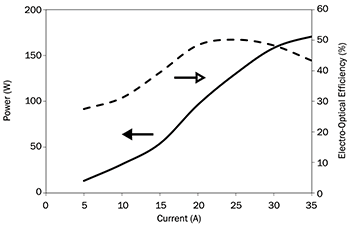
Figure 5. Power and efficiency for a fiber-coupled module (100-µm diameter core, NA of 0.2) based on seven tailored bars, reaching 160 W in 10 mm mrad.
The deviation of the BPP from a single bar to seven bars side-by-side is caused by edge effects of the slow axis collimation lens array. With a setup of seven tailored bars (Figure 4), a fiber-coupled module can be realized with 100-µm diameter core, NA of 0.2. At the design point of 30 A and 150 W, an output power has been achieved with a conversion efficiency of nearly 50 percent (Figure 5). The power curve shows a pronounced “S” shape that can be explained with the laser bar characteristics as a function of current — at low current, the width of the emitter in a gain-guided structure is not well-defined, and current spreading results in a larger emitter and hence a larger spot imaged onto the fiber entrance. With increasing current, the emitter becomes smaller and the coupling into the fiber improves. At even larger current, the blooming of the slow axis divergence again leads to larger spot sizes at the fiber entrance and a rolling in the power at around 30 A.
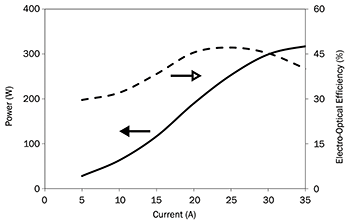
Figure 6. Power and electro-optical efficiency for a fiber-coupled module (100-µm diameter core, NA of 0.2) based on 2 × 7 tailored bars, reaching 320 W in 10 mm mrad.
For further power scaling, polarization multiplexing and wavelength multiplexing can be adopted. As each of the automated manufactured tailored bar arrangements is linearly polarized, polarization multiplexing of 2 × 7 bars is used as a first approach to power scaling (Figure 6).
Another way to increase brightness is wavelength multiplexing. The usage of a number of very different wavelengths with 20- to 40-nm differences and applying dichroitic mirrors for coupling would only allow the coupling of four to five different wavelengths in the high-efficiency semiconductor laser band at 900
to 1000 nm. To achieve higher brightness levels, more wavelengths are required; subsequently, a smaller channel spacing between the different wavelengths is needed, which also makes wavelength stabilization and spectral line narrowing necessary. Our demonstrator is based on three different free-beam modules, each equipped with seven bars and each being wavelength-stabilized with VHG. The center wavelength of the gratings has been set at 972 nm, 976 nm and 980 nm, respectively, and the linewidth of each of the modules is smaller than 0.5 nm (90 percent). Due to the VHGs, the power of each module is reduced by approximately 5 percent. The parallel beams of these three modules are then combined using off-the-shelf dichroic mirrors with an edge steepness of approximately 1 nm, and then focused into a fiber.
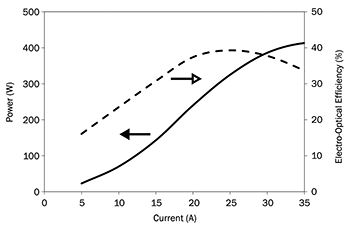
Figure 7. Power curve and electro-optical efficiency of a fiber-coupled module (100-µm diameter core, NA of 0.2) based on dense wavelength multiplexing of three different wavelengths at 972 nm, 976 nm and 980 nm.
Despite the fact that off-the-shelf optics were used for this demonstrator, an output power of 410 W at 35 A with a beam quality of 10 mm mrad (100-µm diameter, NA of 0.2) and an electro-optical efficiency of>40 percent was achieved (Figure 7).
Thus, it is safe to assume that, with optimized optical components, this setup is capable of achieving 500 W with an electro-optical efficiency of >45 percent. Since internally the whole beam path of this dense wavelength multiplexing setup is linearly polarized, the route for 1-kW modules with 10 mm mrad is pretty clear. The inclusion of more wavelengths, including 911 nm, 915 nm and 920 nm, as well as 935 nm, 940 nm and 945 nm, which are well-proven and based on established epitaxies, will allow multi-kW-class diode laser systems to be built.
Meet the author
Dr. Jörg Neukum is the director of sales and marketing at DILAS Diodenlaser GmbH in Mainz, Germany; email: [email protected].